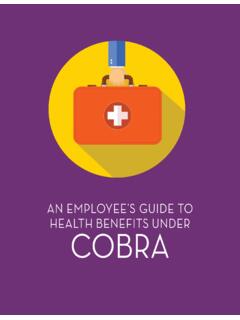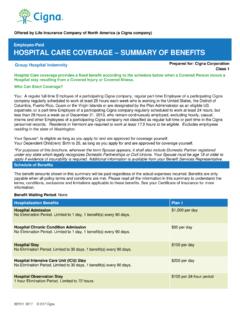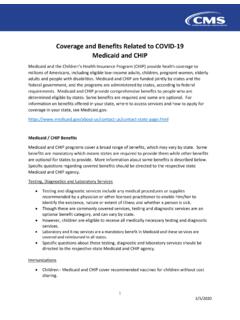Transcription of Understanding the Summary of Benefits and Coverage (SBC)
1 Understanding the Summary of Benefits and Coverage (SBC) Fast Facts for Assisters This Fact Sheet Provides Guidance to Help Assisters:i,ii Interpret the Summary of Benefits & Coverage (SBC) for health plans Assist consumers with using the SBC to compare health plan benefitsSummary of Benefits & Coverage : Overview To help consumers compare the different features of health Benefits and Coverage , the Affordable Care Act generally requires all group health plans and health insurance companies to provide individuals a Summary of Benefits and Coverage that accurately describes the Benefits and Coverage under the plan.
2 The SBC is a snapshot of a health plan s costs, Benefits , covered health care services, and other features that are important to consumers. SBCs also explain health plans unique features like cost sharing rules and include significant limits and exceptions to Coverage in easy-to- understand terms. Along with the SBC, group health plans and health insurance companies must also provide a Uniform Glossary to explain common medical and insurance-related terms. This fact sheet focuses on the SBC provided by health insurance companies that offer Coverage through the Marketplaces. The sample SBC used below is for illustrative purposes only and is not intended to reflect any Marketplace plan option.
3 As consumers compare qualified health plans (QHPs) offered through the Marketplaces, you can help them figure out some of the Benefits offered in each plan by walking them through the SBC. What Assisters Need to Know About Locating the SBC Consumers may access the SBC within each health plan s detailed view at Refer to Exhibit 1 for an example of a health plan s detailed view, which allows consumers to learn more about health plan options before they select one and enroll. CSG-201906 Exhibit 1: Health Plan Details with SBC What Assisters Need to Know When Reviewing the SBC with Consumers Assisters should help consumers understand that all SBCs consist of the following basic parts: Important Questions: Consumers can use this section to understand some of the health plan s costs, including deductible amounts and out-of-pocket limits.
4 This section also contains information on Coverage for in-network and out-of-network providers. Common Medical Events: This section provides cost sharing information for certain common medical events (such as copayments and coinsurance amounts) and significant limitations or exclusions. Services described include a visit to a provider s office, having an MRI or CAT scan, having a hospital stay, and prescription drug information. Excluded Services and Other Covered Services: Consumers can refer to this section to learn about certain services that are not covered by their health plan, as well as some additional services the plan does cover.
5 Coverage Examples: All SBCs include examples of how a plan might cover ahypothetical consumer s health care costs for sample health conditions, such aspregnancy or type 2 diabetes. Consumers should not use these Coverage examples toestimate their actual costs under a plan because actual services and costs depend onconsumers individual medical needs when they consult with a provider. Instead,consumers should use the examples to get an idea of how much financial protection theplan is generally expected to provide for common health conditions. These standardized,hypothetical Coverage examples can help consumers facilitate apples-to-applescomparisons between plans.
6 Uniform Glossary: Each SBC contains a link to a glossary with consumer-friendlyexplanations of common medical and insurance terms, such as deductibles and premiums. All health insurance issuers use the same glossary. You can find theUniform Glossary online, here: should remind consumers that they can use the SBC to answer their general questions about a health plan before selecting a plan for enrollment. Consumers can contact the insurance company offering a plan for information about how it can help them pay for specific health services, and they should review the insurance policy closely. You should also remind consumers that their Benefits and Coverage under a health plan may change during the benefit year, although this is not common, or when a new benefit year begins, which is very common.
7 If information on a plan s SBC changes in the middle of a benefit year, the health insurance company offering that plan must notify consumers of any changes at least 60 days before they go into effect. Before a new benefit year begins, consumers should expect a new SBC from their health insurance company that reflects any changes to their plan that will be in effect during the new benefit year. Scenario: Using the Summary of Benefits to Help a Consumer Choose a Health Plan Ella, a 28-year-old consumer, wants to enroll in a health plan for herself and her husband for the first time. You help Ella submit a Marketplace application and she is determined eligible to purchase a QHP through the Marketplace.
8 Ella has chronic back pain and her husband suffers from asthma, so she s identified a QHP that she believes will provide good Coverage for her and her husband s conditions. However, Ella might need back surgery this year so she is concerned about the plan s prescription drug costs and any costs she may be responsible for if she visits a specialist outside the plan s network. You help Ella review the SBC to learn more about this plan and she asks you following questions: 1. My last doctor said I might need to have in-patient back surgery in the next year. Do I need to get a referral to see a back specialist? First, direct Ella to the Important Questions chart of the SBC.
9 One important question and answer on this chart shows whether Ella would need a referral before she sees a specialist. A sample Important Questions chart is displayed below in Exhibit 2. Exhibit 2: Sample Important Questions Chart 2. If I do need surgery, how much will it cost me to have a surgery on this plan? You should inform Ella that the SBC cannot tell her the exact costs she will pay for a complicated episode of care like back surgery. Her actual services and costs would depend on her particular medical needs, as determined in consultation with her provider. However, you can show Ella two sections of the SBC that will help her understand potential cost-sharing amounts for services she will receive if she gets back surgery.
10 First, direct Ella to the Important Questions chart of the SBC. Explain that Ella must meet the deductible amount in the first row before the insurance company would begin to pay for covered services. In this example, the plan has a $500 per person overall deductible and a $300 specific deductible for prescription drug Coverage . Next, direct Ella to the Common Medical Events chart shown in Exhibit 3 below. This chart starts on the next page of the SBC and shows the potential cost-sharing amounts Ella might be responsible for if she received various health care services after meeting the plan s deductible(s). For example, an office visit with a specialist in the plan s network has a $50 copayment per visit for a participating provider, which means Ella would need to pay $50 each time she visits an in-network (participating) specialist.

















